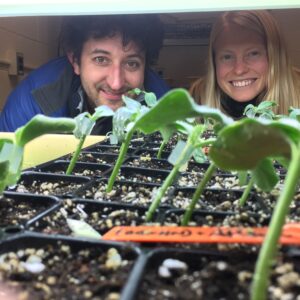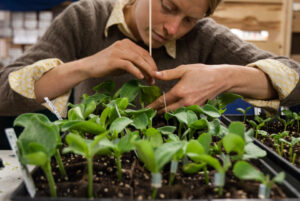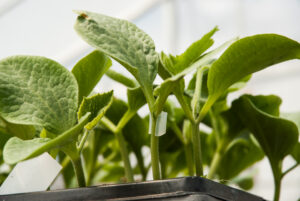Final Report for FNE15-829
Project Information
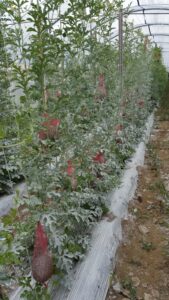 Grafting has the potential to increase organic greenhouse melon production in the Northeast. In 2015, multiple grafting techniques were utilized and healing chamber schedules were developed and documented with initial instruction by Cornell University specialist Michael Mazourek. Many watermelon and cantaloupe rootstock and scion combinations were evaluated in replicated trials at Norwich Meadows Organic Farm, Norwich, New York to identify the combinations of the highest quality in a commercial setting. While data did not provide statistical significance analysis, records show that melon production at Norwich Meadows Farm increased by 15% as a direct result of grafting with the Buttercup X Honeynut rootstock producing the the most abundant marketable cantaloupes than other varieties. No patterns of differences were observed in the grafted watermelon varieties due to the limited numbers of grafted plants grown out. As a result of this research, Farm owner Zaid Kurdieh is expanding his cucurbit grafting in 2016 to include melons, cantaloupes, and cucumbers and is dedicating more than 3 times the hoop house space than the study required. A hands-on grafting workshop at the NOFA-NY winter conference was well-received by 60 attendees. Two articles were accepted for publication in Growing for Market and the Small Farms Quarterly on grafting.
Grafting has the potential to increase organic greenhouse melon production in the Northeast. In 2015, multiple grafting techniques were utilized and healing chamber schedules were developed and documented with initial instruction by Cornell University specialist Michael Mazourek. Many watermelon and cantaloupe rootstock and scion combinations were evaluated in replicated trials at Norwich Meadows Organic Farm, Norwich, New York to identify the combinations of the highest quality in a commercial setting. While data did not provide statistical significance analysis, records show that melon production at Norwich Meadows Farm increased by 15% as a direct result of grafting with the Buttercup X Honeynut rootstock producing the the most abundant marketable cantaloupes than other varieties. No patterns of differences were observed in the grafted watermelon varieties due to the limited numbers of grafted plants grown out. As a result of this research, Farm owner Zaid Kurdieh is expanding his cucurbit grafting in 2016 to include melons, cantaloupes, and cucumbers and is dedicating more than 3 times the hoop house space than the study required. A hands-on grafting workshop at the NOFA-NY winter conference was well-received by 60 attendees. Two articles were accepted for publication in Growing for Market and the Small Farms Quarterly on grafting.
Introduction:
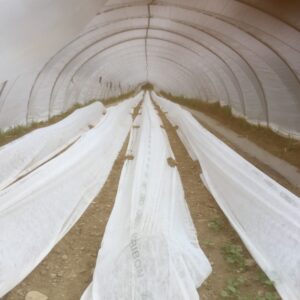 Grafted melons just planted, under row cover.
Grafted melons just planted, under row cover.
Hoop house production of high value crops is expanding in the Northeast. With increased opportunity there is also increased risk of crop loss due to build up of soil pathogens. Grafting disease resistant rootstock to high value and quality fruit scions has proven a successful approach in other regions of the world. If disease resistance in these crops can be attained without affecting fruit quality through grafting, there would be an immediate and significant ecomnic impact for farms in the Northeast to expand hoop house production.
Petra Page-Mann and Matthew Goldfarb of Fruition Seeds grew seedlings and grafted thousands of watermelons and cantaloupes, planting and evaluating them in replicated trials at Norwich Meadows Farm. Michael Mazourek of Cornell University provided insight into the history and practice of cucurbit grafting, offered numerous disease-resistant rootstocks to evaluate and offered extensive technical advise throughout the season. Zaid Kurdieh of Norwich Meadows Organic Farm assisted and innovated the grafting process, dedicated greenhouse space for the entire project, maintained clean fields throughout the season and evaluated melon quality at market.
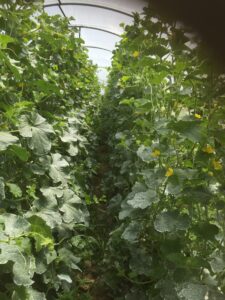 Grafted melons thriving in late June.
Grafted melons thriving in late June.
In January of 2015, Petra and Matthew were taught cucurbit grafting fundamentals from Michael at Cornell and determined planting schedules for appropriate grafting diameters of their trial seedlings. A healing chamber was built at Fruition Seeds in March. Seedlings were grown and grafted using multiple techniques in two successions in April. We experienced issues with germination (especially some seedless watermelon varieties) that significantly decreased the number of plants per rep from 15 to an average of 7 (though some, especially the seedless watermelons, the sample size was too few to replicate), decreasing our desired observations but nonetheless offering us relevant comparisons. Each trial rootstock-scion combination planting was replicated twice with two weeks between the two plants in two well-managed hoop houses at Norwich Meadows. Petra collected bi-weekly data on plant vigor, fruit set timing and quality as well as disease type and percentage. From our observations, Buttercup x Honeynut rootstock produced abundant, marketable cantaloupes more that other rootstocks, on average. We did not observe any patterns in our grafted watermelons, which is not surprising from the limited number of grafts we were able to plant. In the Excel Spreadsheets, the scion selections are the left column and the rootstock selections are the top row. The two reps are represented within a cell (first rep/second rep) and the two successions are labeled (a) and the second (b) on the top row. Vigor (height and overall heath) was given an observation value between A and F, A+ being the most vigorous. Rootstock Abbreviations: Tetsekabuto (Tet), Buttercup x Honeynut (Bc x Hn), Blue Kuri x Honeynut (Bk x Hn), Bugle x Buttercup (Bu x Bc), Bugle x Honeynut (Bu x Hn).
Cooperators
Research
Single Cotyledon Method
Materials on hand:
Rootstock and scion seedlings in flats
Exceedingly sharp, completely clean, very fine blades
Compost bucket
Silicone or plastic graft clips (we prefer silicone)
Labels & Markers
Critical to successful Single Cotyledon grafting is to have both rootstock and scion stems approximately of similar diameter. This can be challenging to manage because rootstocks (generally winter squash) grow quicker than scions (melon and cucumber). We grew out a sample flat of rootstock and scion seeds to get a sense of growth rates to plan our planting progression. As a general rule, planting melon & cucumber scions 7 to 10 days prior to the winter squash rootstock resulted in similar diameter stems perfect for Single Cotyledon Grafting.
Stop watering your seedlings 24 hours before you begin to graft; if they are too turgid they will resist the union, even with clips.
First, with a slanting cut, remove the rootstock’s apical bud, one of its cotyledons and half of its stem one quarter inch below the cotyledon. All that will remain on the rootstock is a single cotyledon and no apical bud. Tuck the rootstock cotyledon in the compost. Second, with a slanting cut, remove the scion’s apical bud, one of its cotyledons and halt of its stem one quarter inch below the cotyledon, just as you did with the rootstock. Third, align the slanting, corresponding cuts on the rootstock and scion and affix a clip to the union. Label your graft with combination (rootstock x scion) and date.
Potential Pitfall: It is vital to remove every bit of the apical bud of the rootstock, which extends a bit below where you can often see the emerging tip. Take a millimeter or two more tissue than you may think is necessary. If the rootstock can regrow at all it will and this decreases its capacity to make a successful union with its scion. It is possible to go back and slice off regrowing rootstock, but it is far from ideal.
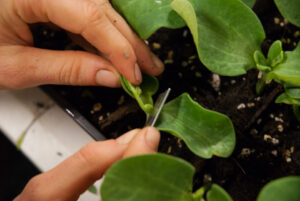 Preparing the rootstock for a Single Cotyledon Graft I
Preparing the rootstock for a Single Cotyledon Graft I 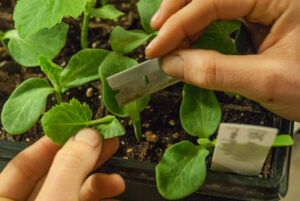 Preparing the rootstock for a Single Cotyledon Graft II
Preparing the rootstock for a Single Cotyledon Graft II 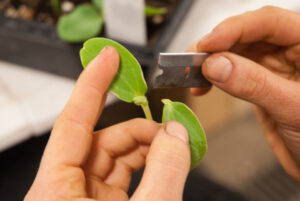 Preparing the scion for a Single Cotyledon Graft I
Preparing the scion for a Single Cotyledon Graft I 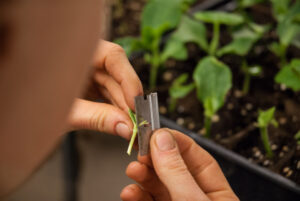 Preparing the scion for the Single Cotyledon Graft II
Preparing the scion for the Single Cotyledon Graft II 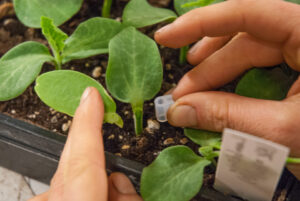 Staging the Single Cotyledon Graft itself.
Staging the Single Cotyledon Graft itself. 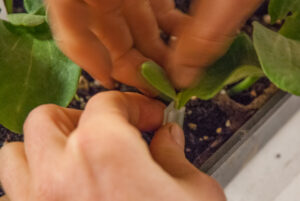 Silicone clips offer stability to the graft while plant union is establishing.
Silicone clips offer stability to the graft while plant union is establishing. 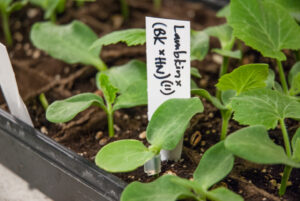 Labeling any graft is perhaps the most important part.
Labeling any graft is perhaps the most important part. 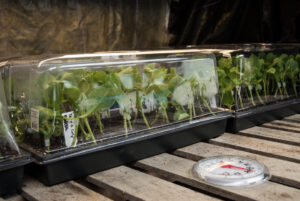 Once grafted, cover with humidity dome move immediately to the grafting chamber.
Once grafted, cover with humidity dome move immediately to the grafting chamber.
Insertion Method
Materials on hand:
Rootstock and scion seedlings in flats
Exceedingly sharp, completely clean, very fine blades
Bamboo Skewer
Compost bucket
Labels & Markers
We appreciate the relative simplicity of the Insertion method versus the Single Cotyledon method. Your goal is to have the rootstock stem diameter large enough so the smaller diameter of the scion can be tucked inside. Rootstocks (winter squash) generally grow quicker than scions (melon and cucumber), so starting them simultaneously results in diameter stems perfect for Insertion grafting. First, fully remove the rootstock apical bud (and any visible axillary buds) and tuck in the compost. Second, take the bamboo skewer and gently insert it into the hole of the rootstock stem and gently twist. This expands the diameter of the rootstock stem ever so slightly and collapses the cell walls of the inner stem, allowing it to make its union with the scion more readily. Third, cut the top quarter inch of the scion (including cotyledons and apical bud) and shave off a tiny bit of its outer stem, as if you were making a cylindrical stick into a long, fine arrow point. Fourth, insert the ‘pointed’ scion top into the ‘enlarged’ rootstock stem. No clip is necessary for the graft to maintain itself. Label your graft with combination (rootstock x scion) and date.
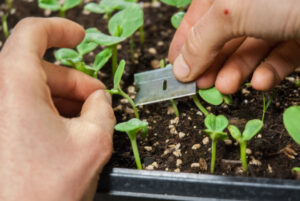 Preparing the scion for Insertion Grafting I
Preparing the scion for Insertion Grafting I 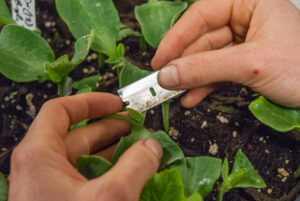 Preparing rootstock for Insertion Grafting I
Preparing rootstock for Insertion Grafting I 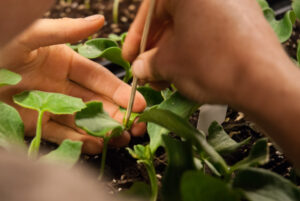 Preparing rootstock for Insertion Grafting II
Preparing rootstock for Insertion Grafting II 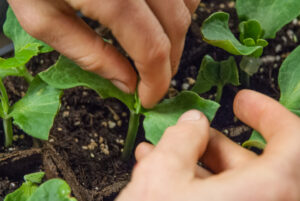 Tucking the scion stem into the rootstock stem, hence an Insertion graft.
Tucking the scion stem into the rootstock stem, hence an Insertion graft. 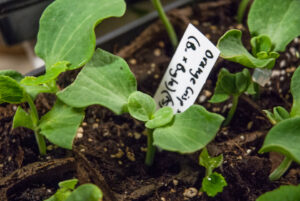 Insertion grafting does not require a silicone clip.
Insertion grafting does not require a silicone clip.  Once grafted, cover with humidity dome move immediately to the grafting chamber.
Once grafted, cover with humidity dome move immediately to the grafting chamber. 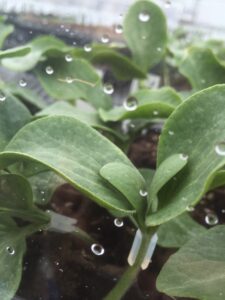 Insertion Graft regrowing in the healing chamber before the dome is removed.
Insertion Graft regrowing in the healing chamber before the dome is removed. 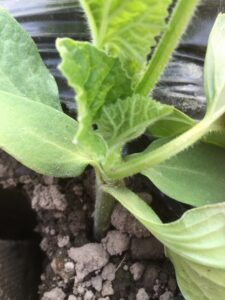 Healthy grafted melon a few days after planting.
Healthy grafted melon a few days after planting. 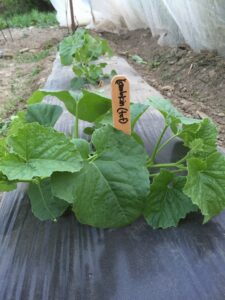 Grafted melons two weeks old, just beginning to vine.
Grafted melons two weeks old, just beginning to vine.
Healing Chamber
Materials:
Benches (to build chamber around)
Flats of grafts
Grafting humidity Domes
Spray bottle with Water
Thermometer
Black Plastic
Clear Greenhouse Plastic
Heater
Florescent lights
Timer
Humidifier
(In our experience, the healing chamber has greater margin for error than the grafting itself. Here is the general idea with our lessons learned.)
Healing chambers may be built in various dimensions; what makes a healing chamber for grafting is its ability to be entirely dark or selectively light and be closely temperature/humidity controlled. We built our healing chamber underneath a bench in the greenhouse, making walls with a layer of clear greenhouse plastic on the inside and a layer of black plastic on the outside. We taped a long, light weight pipe at the bottom of these so we could roll up each side of either black plastic or both black and clear plastic either part way, all the way or not at all. Palates kept flats off the ground. A heater and humidifier inside the chamber was programmed to maintain ideal temperature of 80F and humidity levels at all times.
General Protocol:
As quickly as possible, cover tray of grafted cucurbits with a grafting dome whose inside has been sprayed with water and vents are fully closed. Tuck tray in 80 degree F healing chamber with 100% humidity and exclude all light for 48 hours. Next steps are a general transition; more research is needed to give an exact schedule. What happens next is a gradual introduction of light and decrease of humidity. Light is introduced first with florescent lights at about 4hrs on day 3, 6 hours on day 4, and 8 hours on day 5. At day 6 we the lights are on 8 hours and the sides are pulled up for 4 hours to allow for some natural light. Day 7: add an additional 4 hours of natural light. Day 8: add 4 more hours of natural light. Day 9: allow full natural light by lifting up the black plastic (maintaining the clear plastic) on the sides of the chamber by a quarter on day three, then half on day four, then three quarters day five, then full light for the duration. Humidity is 100% initially, both in the chamber as well as in each completely closed dome. On day four, open the vents on each dome by a quarter. Day five, half. Day six, three quarters. Day seven, open dome vent fully. Grafts that have formed a successful union will be visibly growing by now. On day nine remove the dome and plant out on day 10 or soon after.
Note: If you see mold forming on any leaves, remove it with a sterile knife immediately.
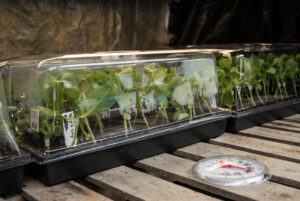 Grafted melons in the healing chamber.
Grafted melons in the healing chamber.
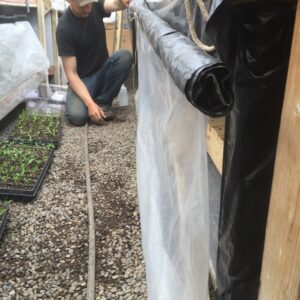 Healing Chamber walls have both black and clear plastic layers that can be adjusted separately.
Healing Chamber walls have both black and clear plastic layers that can be adjusted separately.
Data collection files
Copy of Canteloupe-Grafting-2015
Copy of Watermelon-Grafting-2015
Results
Petra collected bi-weekly data on plant vigor, fruit set timing and quality as well as disease type and percentage. From our observations, Buttercup x Honeynut rootstock produced abundant, marketable cantaloupes more that other rootstocks, on average. We did not observe any patterns in our grafted watermelons, which is not surprising from the limited number of grafts we were able to plant. In the Excel Spreadsheets above, the scion selections are the left column and the rootstock selections are the top row. The two reps are represented within a cell (first rep/second rep) and the two successions are labeled (a) and the second (b) on the top row. Vigor (height and overall heath) was given an observation value between A and F, A+ being the most vigorous. Rootstock Abbreviations: Tetsekabuto (Tet), Buttercup x Honeynut (Bc x Hn), Blue Kuri x Honeynut (Bk x Hn), Bugle x Buttercup (Bu x Bc), Bugle x Honeynut (Bu x Hn).
Interpretation of collected data
- Though less tenacious than tomatoes, cucurbits are still relatively easy to graft and successful unions can be made from surprisingly diverse stem diameters.
- Many variables in the healing chamber seem to have greater impact on grafted cucurbit quality than on the quality of the graft itself. Variables include temperature, humidity, light exposure, dome air opening schedule, total time in chamber and duration of hardening off afterward.
- Axillary buds that have not emerged from the meristem are essential to remove (and are easy to miss) in cucurbit grafting. Our first planting had 20% regrowth of rootstock we had to cut back. Our second planting had 2% rootstock regrowth.
- Some grafts were notably more vigorous than others (see attached spreadsheet) though we did not see any clear trends. For example, "Tetsekabuto offers universal soil-borne Alternaria resistance as a rootstock for cantaloupe" is not accurate. There were, however, some rootstocks (like Buttercup x Honeynut) that appeared to confer broader general resistance than others, especially in cantaloupes.
- Norwich Meadows was able to bring more than thousands of dollars of certified organic, high quality melons to market as a result of our project.
- Some minimal but notable fruit quality issues arose (which was expected from the literature), especially in the seedless watermelons, and we were not able to identify which rootstock-scion combinations were the culprits. All the fruits we evaluated were not expressing susch traits but there were a few combinations we were not able to taste.
Norwich Meadows is incredibly enthusiastic about understandings gained from this project. His organic melon yields increased by 15% as a result of the grafting, even with our mixed successes. Zaid is expanding his cucurbit grafting in 2016 to include melons, cantaloupes and cucumbers. He is continuing to experiement with rootstock-scion combinations and is dedicating more than 3 times the hoop house space than we grew in 2015. In January 2016, Zaid and Petra presented a hands-on cucurbit grafting workshop at NOFA-NY. Michael Mazourek supplied 15 flats of rootstock & scion seedlings from the Cornell greenhouses. Over 60 people were able to learn about and experience cucurbit grafting. From both personal conversation and conference evaluations it was very well received. In May 2016, both Growing for Market and Small Farms Quarterly magazines are publishing 1200 and 700 word articles (respectively) by Petra about cucurbit grafting in the Northeast.
Education & Outreach Activities and Participation Summary
Participation Summary:
In January 2016, Zaid and Petra presented an hour and a half long, hands-on cucurbit grafting workshop at NOFA-NY. Michael Mazourek supplied 15 flats of rootstock & scion seedlings from the Cornell greenhouses. Over 60 people were able to learn about and experience cucurbit grafting. From both personal conversation and conference evaluations it was very well received. In May 2016, both Growing for Market and Small Farms Quarterly magazines are publishing 1200 and 700 word articles (respectively) by Petra about cucurbit grafting in the Northeast.
Project Outcomes
Future Recommendations
To realize the full potential of grafted cucurbit production in the Northeast, identifying successful rootstock-scion combinations in replicated trials is necessary. Further research is needed to indentify best practices in terms of healing chamber protocol, as well.
